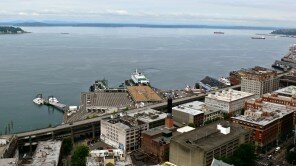
Opening today:
City Arts Festival
The Uptown, under SIFF management
The Microsoft Store at University Village
Dick’s Drive-In in Edmonds
Saving Aimee (to the “press“) at the 5th Ave
Closing tomorrow:
The Viaduct (until October 31).

Opening today:
City Arts Festival
The Uptown, under SIFF management
The Microsoft Store at University Village
Dick’s Drive-In in Edmonds
Saving Aimee (to the “press“) at the 5th Ave
Closing tomorrow:
The Viaduct (until October 31).
Traffic was going to be a little hinky at times anyway this weekend, thanks to Saturday Huskies (12:30 p.m.) and Sounders (7:30 p.m.) games, but WSDOT is also going to be working on the 520 bridge, which is slightly less old than its namesake, Albert Rosellini, who died this week at 101.
Well after the Huskies play, at 8 p.m., both directions of the SR 520 floating bridge and highway and all ramps between Montlake Boulevard and I-405 will be closed until 5 a.m. Monday. You will be able to get on 520 at Montlake and get to I-5; it’s just east to the bridge that’s closed for the weekend. If you normally drive I-90, expect to see a lot of new, somewhat harried faces, especially just before the Sounders game starts.
There’s also the Puget Sound Heart Walk (which has raised $1.2-ish million of its $1.6-million goal). That begins at 9 a.m. Saturday, with walkers taking off from Fisher Pavilion, walking around Seattle Center, and heading down Second Avenue to Seneca and back. King County Metro is publishing a list of reroutes, so don’t get smug, bus riders.
Think of all this as practice for the Alaskan Way Viaduct closure coming up on October 21. For this news, WSDOT grabs the boldface pixels: “At 7:30 p.m. Friday, Oct. 21, 2011, the State Route 99 Alaskan Way Viaduct will close for nine-days.” Nine-days is so long, it gets a hyphen!
The nine-day closure of the viaduct will be the longest ever for a Seattle area highway. With one of the major north-south highways through Seattle closed, drivers from across the Puget Sound region will be significantly affected by the closure. Even if you commute from Lynnwood and Bellevue, you will see increased congestion as the nearly 110,000 drivers that use the viaduct daily look for somewhere else to go.
Where’s your bus? Writes Metro’s Kevin Desmond: “Metro will move 11 routes from the viaduct to Fourth Avenue South. After the viaduct reopens, those routes will begin using the new viaduct bypass.”
This closure will be interesting to watch–if not experience–because nine days is long enough to force behavior patterns to change. If there’s no carpocalypse, people may ask themselves why the state and city chose the single most expensive Viaduct replacement option on the table.
On the other hand, if carmagedd0n does come, that’s a glimpse of life in the near future, as construction ramps up. Per Seattlepi.com: “The $30 million set aside to increase Seattle transit options during the construction of the tunnel replacement for the Alaskan Way Viaduct will run out by 2014 – two years before the project is finished, the City Council was told Tuesday.”
The Seattle City Council is all over this newfangled blogging thing the kids are always on about. No longer to they have to beg the Seattle Times for space on the op-ed page. Some are more prolific than others: Tim Burgess I think leads the way–he even has his own blog–but Sally Bagshaw is right in there. Nick Licata writes frequently, with a monthly round-up. Sally Clark writes once or twice a month, just ahead of Bruce Harrell. Jean Godden was last heard from in March, and the sporadic Tom Rasmussen has let six months go between posting.
Here’s Council President Richard Conlin on how “the tunnel project has wound up funding Seattle street repairs,” thanks to the city pocketing some $3 million from the sale of the “Rubble Yard.” As the city is some $578 million behind in arterial maintenance, that $3 million is less impressive than it might first sound. At least, notes Conlin, it’s not all going on quick fixes:
While some of this will be used to fill the proliferation of potholes, most of it is being used for longer term repairs, such as replacing concrete panels and repaving deteriorated asphalt streets. While pothole repairs are important short-term steps, these more substantial repairs will address a number of major problems that are more serious than potholes, and will provide fixes that will last for many years.
Conlin also provides a short crash-course in why Seattle streets look the way they do, and what’s been done the past few years to remedy that.
For a bigger number of dollars saved, turn to Tim Burgess and his post on how “Seattle avoided spending millions on a new city jail.” It’s an interesting story, turning as it does on the Council uniting to refuse to spend hundreds on millions on a huge project whose necessity arose from a flawed usage forecast:
The Council will vote in early September whether to approve a new jail services contract with King County through 2030. If approved, the new contract will save Seattle taxpayers approximately $200 million in jail construction costs and multiple millions more in operation costs.
Burgess credits King County Executive Dow Constantine for changing the conversation: Constantine agreed that “planning for jail services should be an ongoing regional task with representatives of the County’s larger cities actively participating.” That kind of bottom-up planning would be a wonderful model to export to other areas, such as transportation.
Speaking of transportation, God love Mike O’Brien for sticking his neck out for an $80 vehicle license fee, while the King County Council remains deadlocked over a $20 version to fund Metro Transit.
O’Brien’s politically cannier colleagues have staked out lower-cost fees, recognizing that the mood is ugly; he’s aware–“some of my colleagues on the Council feel like $80 is too high and that we need to look at a lower increase, maybe $40 or even $60″–but he wants to push ahead: “additional revenue is needed to not only maintain Seattle’s transportation infrastructure, but to expand it to provide improve mobility for all residents in Seattle.”
Perhaps, O’Brien says, there is a way to make the fee less regressive, in terms of its impact on “lowest-income residents.” His main point, though, is that there’s substantial overlap between low-income residents and not owning a car. So it’s not just a question of how this will affect the minimum-wager who drives a beater to work, but how it will affect the minimum-wagers who take transit.
If you’ll permit me the observation, this isn’t going to “git ‘r’ done.” I doubt that the populace is in the right frame of mind for anything but specifics. If you’re going to ask for $80, you need to show exactly how that money is going to be spent, and how it’s going to benefit Seattle. Squishily “maintaining” and “improving” isn’t going to win you votes, and bike paths will likely lead to your summary execution. (I do believe drivers would pay to keep bicyclists out of their way–I’d like to see Sally Bagshaw run up a few low-cost bike-boulevard flags and see if anyone salutes.)
You need to demonstrate that $79 is too little, and $81 is more than necessary. If you’re suitably Machiavellian, you perhaps go public first with an outer-bound number, to set an anchor point in people’s minds, and then let yourself be talked down. But for heaven’s sake, don’t let the discussion be about $80–any reasonable person would rightly prefer to keep $80 in their pocket. The discussion has to be about a tangible, concrete accomplishment (or example of a benefit).
To read Publicola’s recap of the Council’s discussion, no one else has reached that level of clarity either. It sounds like the Council is simply taking the temperature to see what people might be willing to pay, rather than building arguments from either necessity, or civic desire. That has been the usual approach of this Council as it cowers from the effects of the recession, makes ritual budget sacrifices, and hopes for brighter days.
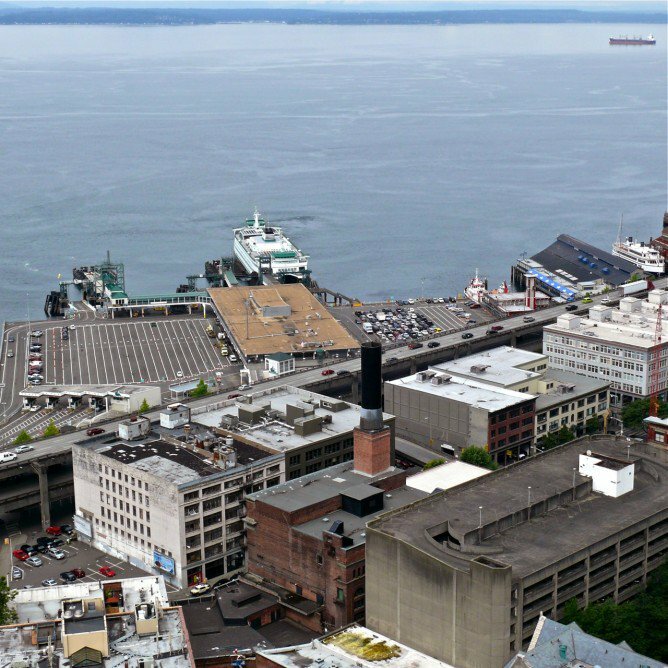
“One thing is certain,” writes the Seattle Times editorial board, “the battle […] has raged too long.”
They are tired of “adding long months of delay to a critical project that some think already is a decade or so overdue.” Considering that “the freeway is almost at capacity at peak periods,” delay is too “costly in terms of in terms of time lost, higher construction costs and inconvenience to the public.”
Seattle needs to build the R.H. Thomson Freeway through the Arboretum. And probably another floating bridge from Sand Point to Kirkland.
The logic is fairly merciless, and if it was true in 1967, then imagine how true it is today, 44 years later, with the Expressway still incomplete. We knew we needed that new highway “as early as 1954.” It’s insane, and I for one applaud the Seattle Times for sticking to their guns on this one.
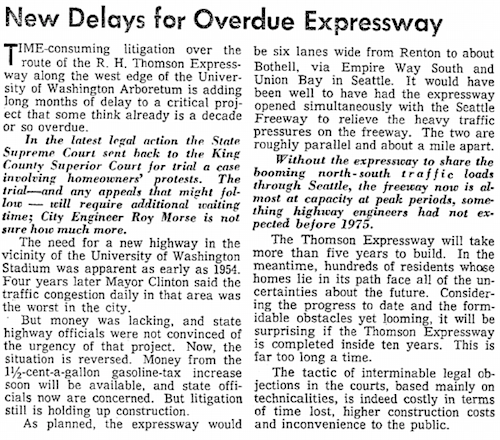
Win or lose, it’s a matter of principle. You cannot afford to shilly-shally on matters like these. And you see an admirable consistency in the Seattle (Daily) Times editorial board, because a full two years later, in 1969, they’re back with an other editorial titled “An Unacceptable Delay.” In fact, this time it’s “wholly unacceptable.”
We are not going to get a fourth bridge across Lake Washington without a Thomson Expressway. WSDOT says the bridge “would serve no useful purpose” without the Expressway.
Now, it is true that the “Times is among those hopeful that means can be found to spare the city the construction of a full-blown Thomson freeway.”
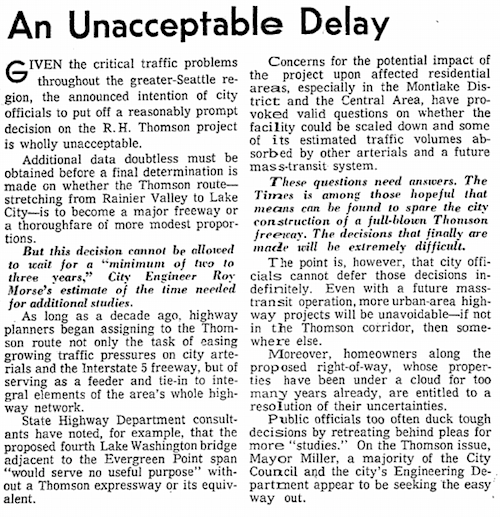
Let’s not get bogged down in minutiae…the point is that delays are unacceptable. Yes, we may in time change our minds totally about what’s necessary, but we can afford to lose no time in springing into action. After all, if we had simply built a six-lane expressway through the Arboretum in the first place, you can see how much easier would it have been to spare the city the construction of a six-lane freeway.
Again, it’s a merciless logic. Geometric, really. That’s why–and I apologize for getting today’s editorial mixed up with one from 1967, but they’re all of a piece, as you can see–that’s why, and here I do differ slightly from the Times, but by god it’s been 44 years: We’ve got to build the R.H. Thomson Expressway and a fourth bridge across Lake Washington first, before we move on to the tunnel. Or, failing that, build them all at once.
It’s like the Times says, “For many decades, the city has needed additional north-south capacity to move people around. […] There is no way Seattle could be better off without four lanes of the tunnel.”
But if this is true–and what reason do any of us have to doubt the editorial board’s grasp of transportation necessity?–then it must also be true that there is no way Seattle could be better off without the six-lane Expressway sending cars zipping through the Arboretum. Let’s “move commuters, freight and a nettlesome community dialogue forward,” because there’s simply nothing worse than delay when it comes to transportation megaprojects. History demonstrates it.
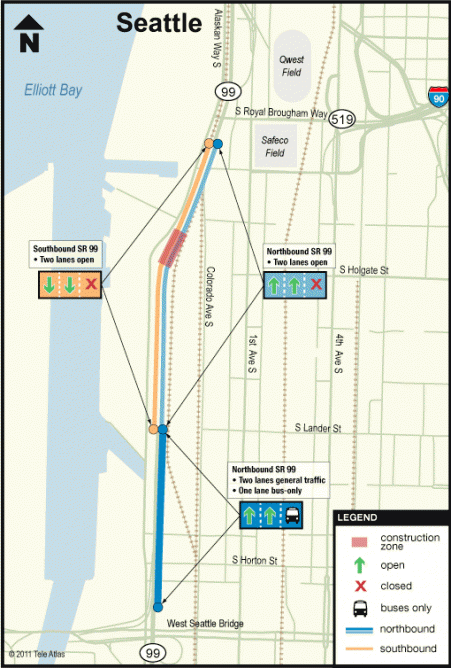
On May 16, after a weekend closure of the Alaskan Way Viaduct, SR 99 will narrow from three lanes to two each way, northbound and southbound, between the West Seattle Bridge and the stadium district. For about a third of the distance northbound, from the bridge to where South Lander would be, there will also be a bus-only lane.
West Seattle Blog commenters smell impending disaster, but since the lane closure is supposed to last until 2013 (“and possibly longer,” adds WSDOT), there will be plenty of time for drivers to explore alternatives. The new speed limit for the section will be 35 mph, instead of 50.
Mike Lindblom reports in the Seattle Times on Metro’s gearing-up for construction-fed ridership, though rush-hour buses have already been filling up in advance of the lane closures:
Last year, King County Metro Transit added 31 trips to its 21 Express, 56 Express and 121 routes serving southwest neighborhoods via the viaduct, and ridership is up 11 percent, said spokeswoman Linda Thielke.
Metro is studying plans for more trips on the 54 and 120 routes this fall, she said. Quicker RapidRide service to West Seattle, Aurora Avenue North and Ballard remains a year or more away.
For its part, WSDOT notes that “$125 million in alternative routes, transit service and traveler information” has been invested to help mitigate the impact of the lane closures. This construction on the southern end of the Viaduct replacement project is not supposed to be contingent upon construction of the central part, which has yet to reach the final stage in the environmental review process.
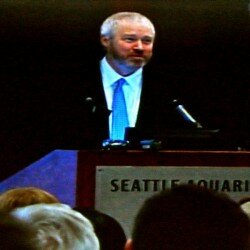
The Seattle Times has a story on Mayor McGinn’s opposition to the tunnel that, refreshingly, casts him as a Machiavellian power-broker able to sway the national levels of environmental organizations: “Sierra Club digs into tunnel fight; too cozy with McGinn?”
This provides balance to their view that he’s completely incompetent.
But much more interesting than that is the conclusion of the article, which contains a roundup of the environmental groups that either support the tunnel or haven’t taken a position.
Not all environmental groups in the region share the Sierra Club’s view that the tunnel is the worst environmental option to replace the viaduct.
Several point out that tearing down the viaduct allows the city to create an appealing green space along the waterfront, reduces surface-water runoff into Puget Sound, eliminates a huge source of noise pollution, and combats sprawl by making the city a more desirable place to live.
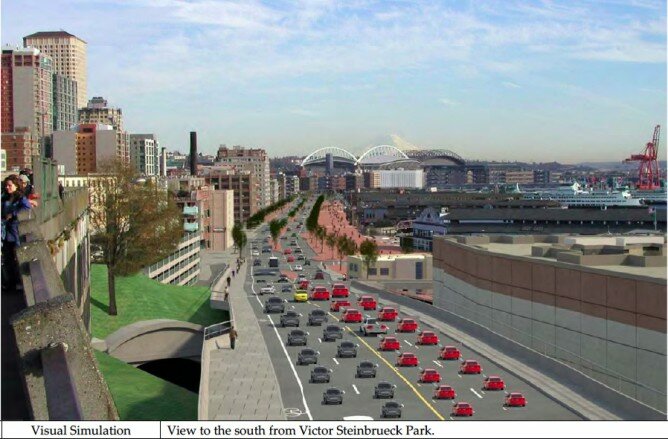
I would suggest that if you support any of the following organizations for actual environmental reasons, you might want to rethink that support, or at least ask them to rethink their responses to the media: Washington Forest Law Center, Washington Conservation Voters, People for Puget Sound, and Washington Environmental Council.
The Times quotes Clifford Traisman, lobbyist for Washington Conservation Voters and Washington Environmental Council, saying, “It’s not a black-and-white environmental issue.” (According to WSDOT’s SDEIS, only the I-5/Surface/Transit option helps lower greenhouse gas emissions, which in principle is a top priority of the state.)
For a rebuttal to that position, visit the policy wonks at Sightline for their extensive analysis of what the tunnel’s impacts are. This vociferousness isn’t like them, by the way–it’s just that they can’t find a worthwhile benefit the tunnel provides for the cost. It could hardly be less black-and-white, unless you’re of the opinion that single-occupancy vehicles are greener than transit.
Note the benefits, above, which are not at all exclusive to the tunnel, though they are presented that way. Certainly a waterfront green space and reducing surface street run-off are not. (I want to take issue with “eliminates” a huge source of noise pollution, as the tunnel would exhaust both car exhaust and tunnel noise into the city above.) The notion that the tunnel “combats sprawl” (what an active verb!) is new to me, and I note that there are no data points associated with this startling claim.
In short, it’s simply intellectually indefensible to suggest that the tunnel is a green option, or that it is “as green as” an option that seeks to shift capacity concerns from vehicles to people. I expect tunnel proponents to elide the difference, but theoretically environmental organizations would know better.
Speaking of intellectually indefensible, the Seattle Chamber’s Tayloe Washburn has penned an op-ed in which he asks readers to use their imaginations when planning traffic flow for transportation projects: “Now close your eyes for a moment and picture your commute on a rainy Friday evening if the mayor got his way and 110,000 additional cars and trucks were forced onto I-5 and city streets.”
Washburn hasn’t gotten his statistics right: it’s 110,000 vehicle trips, not different cars and trucks, unless he’s imagining–and it occurs to me this is where the problem might be–commuters driving off from home each day and never returning. But I think we can agree that, in general, we don’t want to leave transportation planning to a large group of people standing around with their eyes closed.